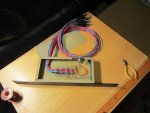Dj Subjective
New member
Hi there guys, ive been researching how to make Passive Summing mixers, and i have lots of info to build 1.
My question is maybe simple to answer, i have lots of schematics for allsorts of different configurations, but none of them seem to have different inputs in the same circuit eg 8 unbalanced ins, or 8 balanced ins.
I have just got a focusrite saffire pro 24, and it has 2 mic pres + 2 line ins, 6 balanced outs, and a stereo headphone out.
now im pretty shure i can make an 8 channel summing mixer out of this configuration, just dont have the expertise to solve my problem. I want to run the 6 balanced outs as 3 stereo mixes, and use the headphone out as a stereo channel to make up channel 7 and 8. im going to run it back through the 2 pre's for makeup gain.
So ill have 4 stereo groups getting summed, with the first 6 outs from my saffire running to balanced ins on the summing mixer, but what do i do with the 1/4inch headphone stereo out from the saffire ? as im shure headphone outs are not balanced.
Any ideas and schematics would be great thanks, plus this will be a passive box so no pots, switches or buttons, just copper rails, resistors, 8 ins & 2 outs stereo.
My question is maybe simple to answer, i have lots of schematics for allsorts of different configurations, but none of them seem to have different inputs in the same circuit eg 8 unbalanced ins, or 8 balanced ins.
I have just got a focusrite saffire pro 24, and it has 2 mic pres + 2 line ins, 6 balanced outs, and a stereo headphone out.
now im pretty shure i can make an 8 channel summing mixer out of this configuration, just dont have the expertise to solve my problem. I want to run the 6 balanced outs as 3 stereo mixes, and use the headphone out as a stereo channel to make up channel 7 and 8. im going to run it back through the 2 pre's for makeup gain.
So ill have 4 stereo groups getting summed, with the first 6 outs from my saffire running to balanced ins on the summing mixer, but what do i do with the 1/4inch headphone stereo out from the saffire ? as im shure headphone outs are not balanced.
Any ideas and schematics would be great thanks, plus this will be a passive box so no pots, switches or buttons, just copper rails, resistors, 8 ins & 2 outs stereo.
Last edited:


